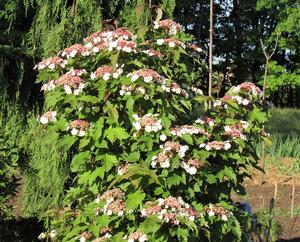View All Plants :: View All DECIDUOUS SHRUBS
Viburnum sargentii 'Onondaga'
Sargent Viburnum
Plant Type:
DECIDUOUS SHRUBSViburnum sargentii ‘Onondaga’ – This is a striking form of the Sargent Viburnum. Red buds open into huge lace cap flowers, white edged with just a touch of dull maroon. Dark red-maroon emergent leaves mature green but maintain a maroon infusion in the growing season. Some autumns the foliage develops respectable rich red shading though this is not a consistent feature. Red fruits are somewhat sparse but light up against the dark-toned foliage.
Beth H. (MI) wrote on October 15, 2019: "I received my Viburnum this past Thursday in excellent condition and planted it this weekend. I'm thrilled with the size and quality of the plant! thank you so much for making this difficult to find shrub available! I had one at a previous house that we owned and was so happy to find it at your nursery to plant at my new home. It is indeed a beautiful shrub for all seasons! Happy fall!Beth H."
Characteristics and Attributes for Viburnum sargentii 'Onondaga'
Season of Interest (Flowering)
- Spring
Season of Interest (Foliage)
- Spring / Summer / Autumn
Autumn Interest
- Fruit / Berries / Seed Heads
Nature Attraction
- Songbirds
- Honey Bees & Native Bees
- Deer Resistant
Light
- Full Sun
Attributes
- Specimen
- Screen
- Shrub Border
- Wildlife Garden
- Hedge
- Hedgerow
Growth Rate in the Garden
- Moderately Fast
Soil
- Fertile
- Moist
Origins
- Garden Origin
Propagated By
- Cutting Grown
Genus Overview: Viburnum
Common Name: Viburnum
Viburnum. This genus is full of fantastic, multi-season garden worthy shrubs. Garden heroes. Spring flowers, often large and showy, many with heady sweet fragrance are arranged in cymes. Some smell of musk (Viburnum dilatatum) while others produce no fragrance at all. Flowers are followed with berries. If late season and autumn berries are desired then planting two of a species will ensure fruit set; for instance, Viburnum dilatatum 'Erie' and V. dilatatum 'Michael Dodge' will pollinate each other and produce fruit. Viburnum cassinoides is closely allied with V. nudum; but if the flowering times do not overlap then there will be no fruit. However, if you plant V. nudum 'Winterthur' in proximity with V. nudum var. angustifolium, 'Longwood', 'Moonshine' or 'Pink Beauty' berries will abound. Another interesting example is V. lantana which crosses with V. burejaeticum and vice versa. Any V. plicatum f. tomentosum selection such as 'Shasta' or 'Shoshoni' will pollinate with all other V. plicatum f. tomentosum selections like 'Copper Ridges or 'Pink Beauty'. But if you were to plant two 'Shasta' side by side with no other V. plicatum f. tomentosum in near proximity then your effort will be fruitless. As with almost all in the universe of plants there are exceptions. There is one viburnum which appears to be self-fruitful, Viburnum setigerum the Tea Viburnum. Another interesting exception to the rule is Viburnum nudum 'Pink Beauty' which is also self-fruitful - a departure from its siblings. And on the other spectrum are two I can think of off-hand that are barren, Viburnum plicatum 'Roseum' and Viburnum plicatum 'Kern's Pink'. Oftentimes, the dwarf viburnums reamin in a juvenile state and do not produce fruit. All Viburnum of any size that do produce fruit are magnificent in the late season garden. And they feed all manner of birds. Larger, denser shrubs provide cover and nesting opportunities. Nearly all Viburnum have terrific autumn foliage colors, too. Viburnums are members of Caprifoliaceae. All prefer part to full sun and fertile soils. All are cutting grown. Many thanks to Gary Ladman of Classic Viburnums who generously set us straight regarding some of the details we had originally incorrectly lauded... ya can't know everything!


